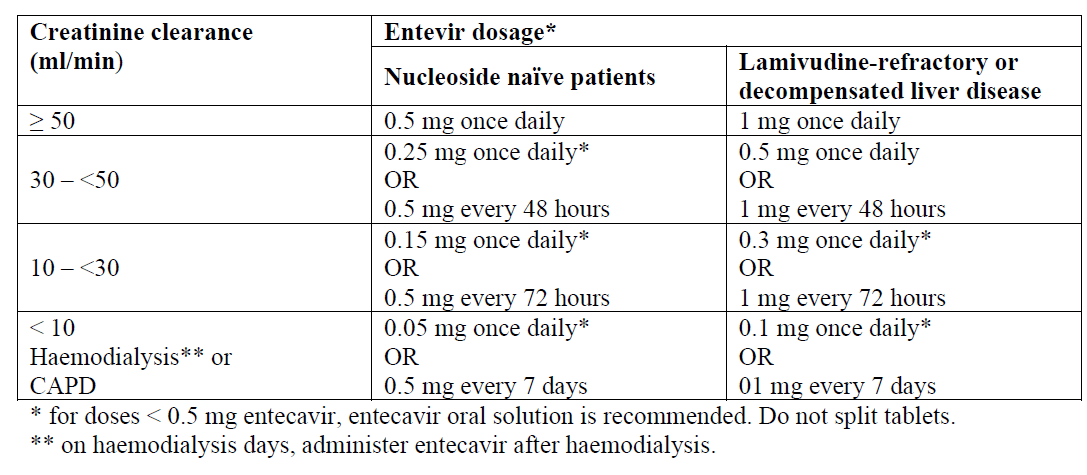Regulatory Information
HSA regulatory responsibility and product classification details
Regulatory Responsibility
Product Classification
Formulation Information
TABLET, FILM COATED
**4.2 Posology and method of administration** Therapy should be initiated by a physician experienced in the management of chronic hepatitis B infection. Posology _Compensated liver disease_ _Nucleoside naïve patients:_ the recommended dose in adults and adolescents 16 years of age and older is 0.5 mg once daily, with or without food. _Lamivudine-refractory patients_ (i.e. with evidence of viraemia while on lamivudine or the presence of lamivudine resistance \[LVDr\] mutations) (see sections 4.4 and 5.1 – _please refer to the Product Insert/Patient Information Leaflet published on HSA for the full drug information_): the recommended dose in adults is 1 mg once daily, which must be taken on an empty stomach (at least 2 hours before and more than 2 hours after a meal) (see section 5.2 – _please refer to the Product Insert/Patient Information Leaflet published on HSA for the full drug information_). _Decompensated liver disease_ The recommended dose for adult patients with decompensated liver disease is 1 mg once daily, which must be taken on an empty stomach (at least 2 hours before and more than 2 hours after a meal) (see section 5.2 – _please refer to the Product Insert/Patient Information Leaflet published on HSA for the full drug information_). For patients with lamivudine-refractory hepatitis B, see sections 4.4 and 5.1 – _please refer to the Product Insert/Patient Information Leaflet published on HSA for the full drug information_. _Duration of therapy_ The optimal duration of treatment is unknown. Treatment discontinuation may be considered as follows: - In HBeAg positive adult patients, treatment should be administered at least until 12 months after achieving HBe seroconversion (HBeAg loss and HBV DNA loss with anti-HBe detection on two consecutive serum samples at least 3–6 months apart) or until HBs seroconversion or there is loss of efficacy (see section 4.4 – _please refer to the Product Insert/Patient Information Leaflet published on HSA for the full drug information_). - In HBeAg negative adult patients, treatment should be administered at least until HBs seroconversion or there is evidence of loss of efficacy. With prolonged treatment for more than 2 years, regular reassessment is recommended to confirm that continuing the selected therapy remains appropriate for the patient. In patients with decompensated liver disease or cirrhosis, treatment cessation is not recommended. _Elderly:_ no dosage adjustment based on age is required. The dose should be adjusted according to the patient’s renal function (see dosage recommendations in renal impairment and section 5.2 – _please refer to the Product Insert/Patient Information Leaflet published on HSA for the full drug information_). _Gender and race:_ no dosage adjustment based on gender or race is required. _Renal impairment:_ the clearance of entecavir decreases with decreasing creatinine clearance (see section 5.2 – _please refer to the Product Insert/Patient Information Leaflet published on HSA for the full drug information_). Dose adjustment is recommended for patients with creatinine clearance < 50 ml/min, including those on haemodialysis or continuous ambulatory peritoneal dialysis (CAPD). A reduction of the daily dose using entecavir oral solution, as detailed in the table, is recommended. As an alternative, in case the oral solution is not available, the dose can be adjusted by increasing the dosage interval, also shown in the table. If appropriate dose adjustment cannot be achieved with Entevir, entecavir oral solution may be checked for its availability. The proposed dose modifications are based on extrapolation of limited data, and their safety and effectiveness have not been clinically evaluated. Therefore, virological response should be closely monitored.  _Hepatic impairment:_ no dose adjustment is required in patients with hepatic impairment. Method of administration Oral use.
ORAL
Medical Information
**4.1 Therapeutic indications** **Adult indication** Entevir is indicated for the treatment of chronic hepatitis B virus infection in adults with evidence of active viral replication and either evidence of persistent elevations in serum aminotransferases (ALT or AST) or histologically active disease. The following points should be considered when initiating therapy with Entevir: - This indication is based on histologic, virologic, biochemical, and serologic responses in nucleoside-treatment-naïve and lamivudine-resistant adult subjects with HBeAg-positive or HBeAg-negative chronic HBV infection with compensated liver disease. - Virologic, biochemical, serologic, and safety data are available from a controlled study in adult subjects with chronic HBV infection and decompensated liver disease (see section 4.4 – _please refer to the Product Insert/Patient Information Leaflet published on HSA for the full drug information_). - Virologic, biochemical, serologic, and safety data are available for a limited number of adult subjects with HIV/HBV co-infection who have received prior lamivudine therapy (see sections 4.2, 4.4 and 5.1 – _please refer to the Product Insert/Patient Information Leaflet published on HSA for the full drug information_). **Paediatric population** Safety and effectiveness of entecavir in pediatric patients below the age of 16 years have not been established.
**4.3 Contraindications** Hypersensitivity to the active substance or to any of the excipients listed in section 6.1 – _please refer to the Product Insert/Patient Information Leaflet published on HSA for the full drug information_.
J05AF10
entecavir
Manufacturer Information
SEA PHARMA CONSULTANCY PTE. LTD.
PHARMATHEN INTERNATIONAL S.A.
PHARMATHEN S.A. (Primary and Secondary packager)
Active Ingredients
Documents
Package Inserts
1.4.3 Entevir Tablet PI_Proposed.pdf
Approved: June 24, 2021
